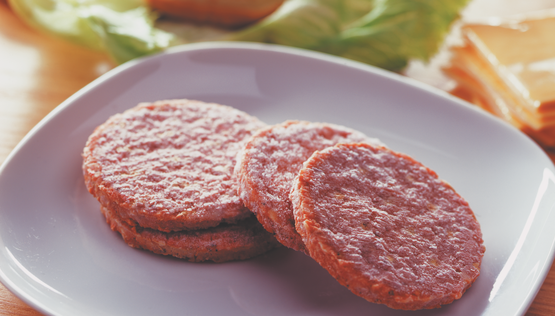As the food industry is providing healthier and less energy-intensive alternatives, cryogenic chilling is a naturally efficient way to cool plant-based meat.
As awareness for a healthy and sustainable diet grows, alternative food products are creating a publicity stir and high economic expectations. Barclays, a London-based investment firm, estimates the market for alternative meat could reach $140 billion (€125 billion) over the next decade, gaining 10% of the $1.4 trillion (€1.25 trillion) world meat market. Alternative meat products are currently at less than 1% of global share.
Whether meat- or plant-based, Burger patties and sausages need to be refrigerated on their way from production to consumption. This is where Linde can support the nascent industry. Cryogenic freezing and cooling, as the use of liquid nitrogen and carbon dioxide is called among experts, has been enhancing food processing for many years. Thanks to their physical properties, liquid nitrogen (LIN) and carbon dioxide (LIC) can lower temperatures as far as –196°C.
“This highly adaptable technology is ideally-placed to support a start-up industry such as the alternative food sector”, says Mark Ewig, responsible for Linde’s global food and beverage marketing. “We can expand, at minimum cost, to meet future increased demands.” This could be relevant to Beyond Meat, Impossible Foods and other players in this rookie industry as they deal with volatile demand.
For more information, feel free to contact us directly.
Not vegan anymore: Alternative food such as plant-based burger patties and sausages have reached a new level.
Heat transfer rates in CRYOLINE® freezers are two to three times those of standard tunnel freezers.
To provide yet more flexibility, Linde also operates an international freezer pool. Here, Linde technology is rented out or, at times, bought back from clients. This pool is large enough to service any short-term needs coming from the meatless industry. “In fact, we can expand a cryogenic machine within a month or two,” Ewig says, not without pride.
Cryogenic freezing maintains high quality and preserves flavour in the chilled products. It provides higher yield due to less dehydration. And despite the sophisticated technology behind the process, Linde’s equipment is delivered 'ready to run' or can be set up within days.
Breaking down barriers
“This is a highly efficient and environmentally-friendly approach,” Ewig continues. “Nitrogen, which exists in the air around us, is a completely natural element.”
Linde’s cryogenic technology is based on creating an air flow within the machine, thereby breaking down a product’s thermal barrier. “Our CRYOLINE® series, for example, delivers heat transfer rates two to three times those of standard tunnel freezers”, says Ewig.
Another key aspect is that at Linde, everything revolves around food safety and hygiene. “All our machinery is built to focus on cleanliness. Our freezers open up and give full access for any cleaning or maintenance exercises”, Ewig says.
ACCU-CHILL® is another highly efficient cooling technology developed by Linde. Its key advantage is efficiency. Conventional cooling tools such as kettle chillers, traditional heat exchangers or scraped surface heat exchangers demand much energy, space and time. ACCU-CHILL BI®, for example, tackles this challenge by pioneering cryogenic gas cooling with an unprecedented energy efficiency of up to 90%.
Modified Atmosphere Packaging (MAP) is yet another technology to extend the shelf life of foodstuffs without altering their physical or chemical properties or adding any unnatural ingredients. “We have developed a range of application-specific packaging solutions under our MAPAX® brand”, Ewig says. “The vast knowledge and extensive experience we have gained in food science can now be harnessed to extend the shelf life of all food products the natural way.”
